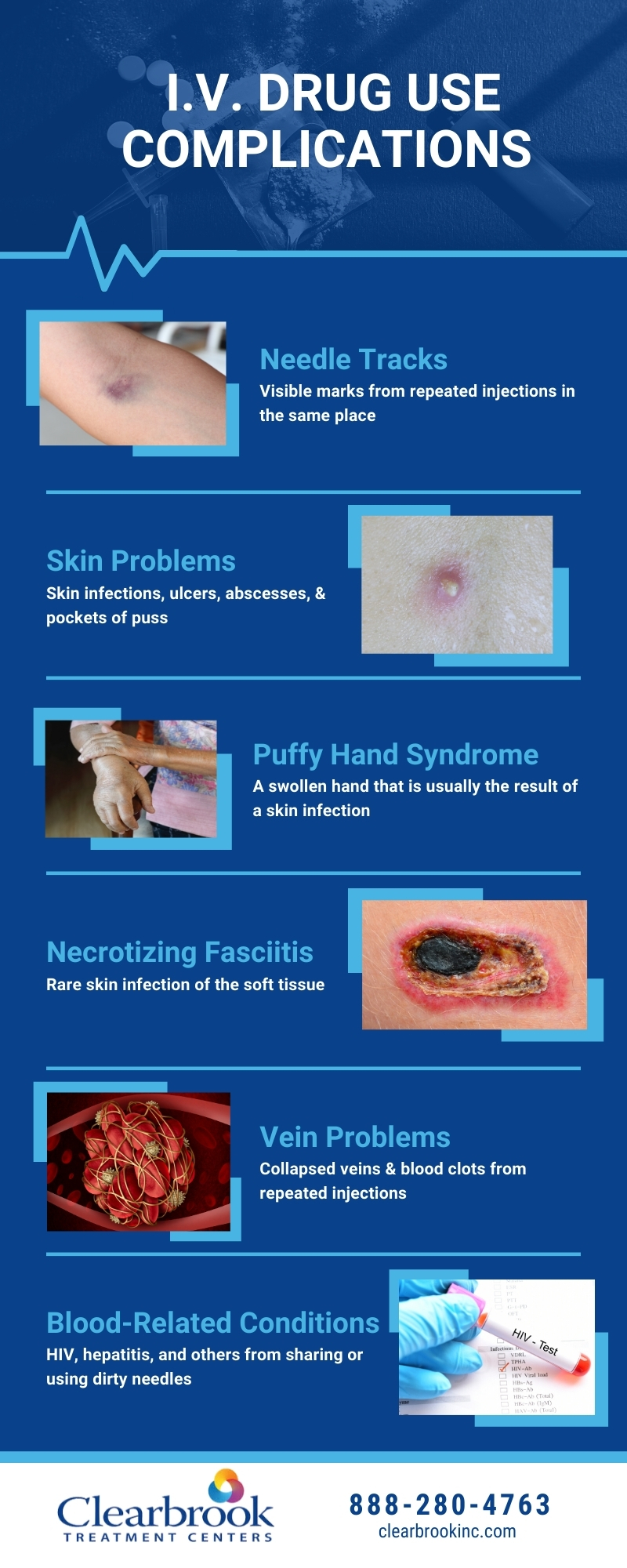Intravenous (IV) drug administration presents a unique and complex set of challenges in the context of substance abuse and addiction, often resulting in various complications. While intravenous drug use carries inherent risks, individuals who misuse substances face an increased likelihood of experiencing complications that can be both acute and chronic. Understanding the common IV drug use within the context of addiction is crucial for healthcare providers, policymakers, and researchers striving to address the multifaceted nature of this public health concern. The addiction experts at Clearbrook Pennsylvania dive into the possible IV drug use health issue, emphasizing the importance of developing comprehensive strategies for harm reduction, treatment, and prevention in the face of this critical public health issue.
What Are Intravenous Drugs?
Intravenous drugs, commonly referred to as IV drugs, include both pharmaceutical and illicit substances that are administered directly into the bloodstream through a vein. This method of drug delivery involves using a sterile needle and a syringe or an IV catheter to introduce the medication into a vein, typically in the arm, hand, or another suitable access point.
Intravenous drug administration is a rapid and precise means of delivering medications, as it allows for immediate absorption into the circulatory system, ensuring that the drug’s effects are felt quickly and in a controlled manner. IV drugs encompass a wide range of therapeutic agents, including antibiotics, analgesics, chemotherapy drugs, and other medications used for various medical conditions, as well as drugs administered for diagnostic purposes.
However, intravenous drug use is not limited to the administration of prescribed medications within the realm of medical practice. Illicit IV drug use, which involves the injection of illegal substances directly into the bloodstream, presents a considerable challenge in the context of public health and addiction. The use of illicit IV drugs is often associated with high-risk behaviors, as it can lead to a range of acute and chronic complications.
Types of Intravenous Drugs
Intravenous drugs include a wide range of pharmaceutical agents used in medical practice for therapeutic and diagnostic purposes, as well as illicit substances that are used for recreational purposes. These drugs are administered directly into the bloodstream, allowing for rapid onset of action and precise control over dosage.
The following is a comprehensive intravenous drugs list:
- Anesthetics: IV anesthetics, such as propofol and etomidate, are used to induce and maintain anesthesia during surgical procedures. They produce a rapid and reversible loss of consciousness.
- Analgesics: Opioid analgesics, like morphine, fentanyl, and hydromorphone, are administered intravenously to provide potent pain relief, particularly in post-operative and acute pain management.
- Antibiotics: IV antibiotics, such as ceftriaxone, vancomycin, and meropenem, are employed to treat severe bacterial infections that require immediate and high-level systemic therapy.
- Anticoagulants: Heparin and enoxaparin are examples of IV anticoagulants used to prevent and treat blood clots in conditions like deep vein thrombosis and pulmonary embolism.
- Chemotherapy drugs: Intravenous chemotherapy agents, including cisplatin and paclitaxel, are utilized in the treatment of various cancers to target rapidly dividing cells.
- Vasoactive agents: Drugs like norepinephrine and dobutamine are administered intravenously to manage blood pressure and cardiac function in critical care settings.
- Intravenous nutrition: Total parenteral nutrition (TPN) solutions provide essential nutrients, electrolytes, and vitamins intravenously to individuals who cannot receive adequate nutrition via the gastrointestinal tract.
- Immunoglobulins: Intravenous immunoglobulin (IVIG) contains antibodies and is used in the treatment of autoimmune and immunodeficiency disorders.
- Diuretics: IV diuretics, like furosemide, are employed to reduce excess fluid in the body, often in cases of congestive heart failure or edema.
- Antiarrhythmics: Medications such as amiodarone are administered intravenously to treat irregular heart rhythms and arrhythmias.
- Antiemetics: IV antiemetic drugs, like ondansetron, help prevent or alleviate nausea and vomiting, commonly used in cancer chemotherapy and post-operative care.
- Diagnostic agents: Contrast agents, such as iodinated contrast media, are used for intravenous imaging procedures, such as CT scans and angiography, to enhance visualization of specific structures.
- Antiviral drugs: Intravenous antiviral medications like acyclovir and ganciclovir are employed to treat viral infections, including herpes and cytomegalovirus.
- Intravenous anesthetics: Intravenous anesthetics, such as midazolam and ketamine, are used for sedation and anesthesia induction in various medical procedures.
- Antifungal drugs: IV antifungals, including amphotericin B and fluconazole, are administered to treat severe fungal infections, especially in immunocompromised patients.
- Heroin: Heroin, a potent opioid, is one of the most infamous illicit IV drugs. Users inject it to achieve intense euphoria and pain relief. Heroin injection is linked to a high risk of overdose, dependence, and infectious diseases due to shared needles.
- Cocaine: Cocaine, a powerful stimulant, is sometimes dissolved and injected intravenously to produce a rapid and intense high. This method increases the risk of heart-related complications, addiction, and infectious diseases.
- Methamphetamine: Methamphetamine, a synthetic stimulant, is injected for its immediate and intense effects. IV methamphetamine use can lead to cardiovascular issues, addiction, and a range of health complications.
- Cathinones (bath salts): Cathinones, synthetic stimulants often sold as “bath salts,” can be injected to induce hallucinations, paranoia, and extreme agitation. IV use of cathinones can lead to severe health crises and psychiatric disturbances.
- Illicit prescription medications: Some individuals misuse prescription medications, such as opioids, benzodiazepines, and sedatives, by injecting them intravenously. This misuse can lead to addiction, overdose, and a host of medical complications.
What Is IV Addiction?
IV addiction, also known as intravenous drug addiction or IV substance use disorder, refers to a specific form of substance use disorder characterized by the compulsive and harmful use of drugs administered intravenously. This addiction typically involves the injection of drugs directly into the bloodstream using needles and syringes, which allows for rapid drug delivery and intense effects. IV addiction can encompass a variety of substances, including but not limited to opioids, stimulants, sedatives, and other drugs.
Some common signs of intravenous drug addiction include:
- Compulsive drug use
- Tolerance and withdrawal
- Negative physical, psychological, social, and legal consequences
- Risk of overdose
- Health complications include but are not limited to infectious diseases, vascular issues, and harm to vital organs and body systems
- Psychological dependence
- Intense cravings
- Failed attempts to quit
Addressing IV addiction often requires a comprehensive and individualized approach. Treatment options may include medical detox to manage withdrawal symptoms, medication-assisted treatment (MAT) to reduce cravings and withdrawal discomfort, various forms of counseling and therapy, and support services. Harm reduction strategies, such as providing access to sterile injection equipment and overdose prevention measures, play a vital role in reducing the associated risks.
The Dangers of Shooting Up Drugs
On top of the fact that drug abuse can damage several aspects of a person’s life, the route of administration can lead to added health problems for the user. While many people may be willing to brush off these warnings, IV drug use complications are no joke. Some can even become fatal if ignored. Some possible IV drug use complications include needle tracks, skin problems, puffy hand syndrome, bacterial infections, vein problems, and blood-related conditions.
Needle Tracks
Needle tracks is a term used to describe visible marks from repeated injections in the same place. Needle tracks often look like black and blue marks or dark spots. Even years after completing drug detox and treatment, these marks may still be visible. Also, drug paraphernalia like syringes is one of the deadly signs of a heroin addiction.
Skin Issues
One of the common effects of shooting up drugs is skin problems. Especially when these injectable drugs are not pure or laced with other drugs, it may result in skin infections, skin ulcers, abscesses, or pockets of pus. These skin infections can result in scarring, swelling, and even fever. Cellulitis, in particular, is a common IV site infection in drug users. One study found that 32% of injection drug users in a neighborhood in California currently had abscesses, cellulitis, or both.1 If left untreated, cellulitis can become serious.
Puffy Hand Syndrome
IV drug use can cause hand complications, as well. Some long-term intravenous drug users will get a swollen hand after shooting up. It is usually the result of a skin infection and can range in severity. If left alone, the swelling may even become permanent. Puffy hand syndrome is estimated to only occur in 7-16% of intravenous drug users but may be more common with heroin users.3 If you start noticing signs of puffy hand syndrome, you should seek medical heroin addiction treatment immediately to quit and keep it from becoming permanent.
Necrotizing Fasciitis
Necrotizing fasciitis is a rare but life-threatening bacterial infection of the soft tissue. It looks like cellulitis but is accompanied by more severe symptoms like severe pain, fever, dizziness, and nausea. Surgery is often required to prevent the infection from spreading.2
Vein Problems
The complications of IV drug use often include problems with the veins. With repeated injections, a person may experience collapsed veins or blood clots like septic thrombophlebitis, which can be life-threatening.4 Without treatment, these veins can be permanently damaged.
Blood-Related Conditions
Because they cannot wait, some drug users will share needles or use dirty needles. The result may be a blood-related condition like HIV or hepatitis. Sharing syringes is the second riskiest behavior for contracting HIV.5 Even if you think the needle may be safe, you could be wrong. HIV can survive in a used syringe for around 42 days.5
Even if you have never had a problem shooting up drugs before, it doesn’t mean you are safe. IV drug user complications can occur no matter how many times you have done it before; all it takes is one dirty needle or bad injection. Instead of continuing to put your life at risk and falling deeper into addiction, our Northeast rehab in Wilkes-Barre can help you overcome your substance abuse and quit for good.
Abusing drugs is dangerous for several reasons, and IV drug use complications are not worth the risk. Instead of letting these substances get the best of you or your loved one, get help. At Clearbrook, we offer several programs to assist people in overcoming their addictions and moving forward with their lives. Reach out to us today at 570-536-9621.
Sources:
- NCBI – Abscess and Self-Treatment Among Injection Drug Users at Four California Syringe Exchanges and Their Surrounding Communities
- CDC – Necrotizing Fasciitis: All You Need to Know
- Hindawi – Puffy Hand Syndrome Revealed by a Severe Staphylococcal Skin Infection
- NCBI – Septic thrombophlebitis in an HIV-positive intravenous drug user
- CDC – Injection Drug Use and HIV Risk








